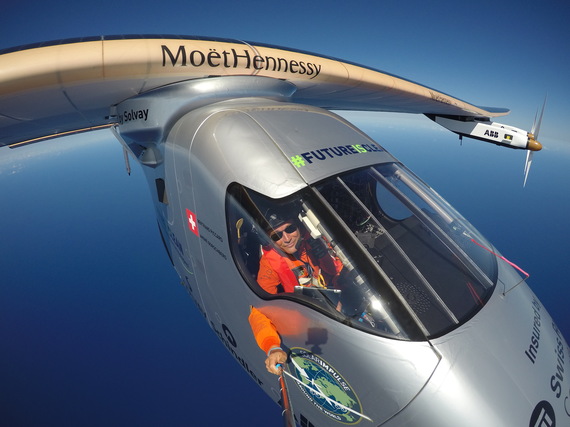Highlights
•The potential of innovation
•A critique of the environmental movement
•People have put plastics into our ocean
•An almost radioactive ocean
The following has been edited for clarity and length.
Andreas Merkl: I'm curious. When you're up there flying, is it a perfectly quiet experience? Or is it the rumble that you get in a typical soaring airplane?
Bertrand Piccard: You have a little whistle of the electrical motors. The carbon fiber makes a little bit of cracks here and there. You feel a little bit of vibrations. But compared to a normal airplane, it's really quiet. When I fly this plane, I have the impression to be in a story of science fiction. I look at the sun and I know it's my only source of power, and it's coming down to leave me energy to continue the flight. Each time I look outside and I say, "It's really magical." And I look the propellers turning, I see these huge wings on my left and my right, and I think, "I'm crossing oceans." It's reality, actually. It's not science fiction. It's magical. It's like a fairy tale.
AM: So, there you are flying off of solar energy in a completely quiet place at 28,000 feet, surrounded by that level of ingenuity and innovation in this magical place. Do you have confidence that we're going to figure out how to keep this planet viable? Or are you more pessimistic than that?
BP: I am optimistic when I see the potential of innovation, the potential of creativity of human beings. I'm pessimistic when I see what people do with this potential. We could already have a world where we [halve] our CO2 emissions, where we [halve] our energy consumption. We could have a world where we get more fishes in the ocean every year instead of less. We can have a world where we stop depleting the natural resources, thanks to renewable energy. We don't do it. This is crazy.
We have regulations for everything, but actually we have no regulation for energy efficiency, which means that we can still put all the CO2 we want in the atmosphere and we have no international regulations for the environment, which means that in international waters, everybody is still allowed to do everything. This is absolutely unacceptable.
Basically we have all the solutions to solve the problem, and they are not used enough.
AM: We don't have a technical problem, right? We have a governance problem.
BP: Absolutely. The technical solutions exist. With Solar Impulse, we show that we have electrical mobility. We have thermal insulation for houses. We have LED lighting systems. We have smart grid systems. We have all the industrial process to be much cleaner. Today, the clean technologies that exist already [could halve our] CO2 emissions, but we need to implement them.
The solutions exist. You can fly with an airplane perpetually with no fuel, and there are still people who say, "No no, we have to keep fuel, we have to do everything like in the past."
AM: That's the power of mental models. The mental model that happiness involves separation from the world through things, rather than a connection to the world, the way that you feel connected when you fly that plane. Your critique of the commercial world also extends to a critique of the environmental movement, where you said it's too fundamental. It's not pragmatic enough. It's going rapidly in the wrong way rather than slowly in the right way. I think I very much agree with you, but I'd love to hear a little bit more on your thoughts on that.
BP: In the last 15 years, the people wanting to protect the environment chose a way that was threatening the lifestyle of the population. They were saying that the environment has to be protected by having less mobility, less comfort, less growth. Less everything.
AM: A less sexy life.
BP: Yes. A less sexy life. How can you motivate people to have a less sexy life? People don't want that. On the other hand, if we continue to have the life we have, we will destroy everything. What we need is to find a solution for both problems. Today, the solution for both problems is called clean technologies. With clean technologies, you reduce energy consumption. You reduce CO2 emission. You reduce the depletion of natural resources. You protect the environment.
AM: I know that you come from a lot of work with Covestro, some of it also on plastics, on the film applications on your plane. There was a lot of innovation that went on there.
BP: It's interesting you see that the plastic industry, or the chemical industry, was the part of the problem in the past. Now they become part of the solution because they are providing new industrial process and new materials to be more clean.
It's interesting that now all this plastic could be collected and turned into fuel, or turned into solid plastic. I saw some samples of very good quality of plastic that can be used for whatever. For cars, for houses, for everything. This comes from the recuperation, of the recycling of this plastic which is now floating into the ocean. Today, there is a new industry that can be profitable, to solve the problems that have been caused in the past.
AM: Can we talk a little bit about the bad side of plastics? As you have flown the plane, you have described this, that flying the plane you have looked down on continents of plastics in the ocean. Can you talk a little bit about that?
BP: It's true that for dozens of years, people have put plastic into the oceans. Because of the currents, some places in the oceans have concentrated thousands of square kilometers of plastic.
AM: Have you seen that from the plane?
BP: No. You don't see it. It's not something solid you can walk on. It's like jelly of plastic, into the first couple of meters of water, on the surface. This kills animals in a terrible way, pollutes everything.
AM: Ocean Conservancy is very much in the lead of attacking this problem. In all of our research, what it shows is that as bad as those gyres--those continents of plastic there--they only contain about 2 percent of all the plastic that's in the ocean. Most of the plastic that's in the ocean, which is about 8 million tons a year, about a total right now of 150 million ... There's about to be 250 million tons, which is about 1 ton of plastic for every 3 tons of fish. Most of it is not floating in the gyres. It could be actually inside the animals. It's really terrifying.
BP: Exactly. I was talking with Covestro about that. They are saying, "Our goal now is to turn off the tap." The problem has to be solved, but first we have to stop putting this plastic into the oceans. This reminds me of what was happening in 1960 when my father made the dive to the deepest point in the ocean in the Mariana Trench with the Bathyscaphe that he had built with my grandfather. You might not remember the situation, but in those times, in 1960, the government wanted to use the deepest trenches [of the ocean] to [dispose of] radioactive waste. They thought down there, it would disturb nobody. There is no life and no problem.
The goal of the dive of my father was to see if there was life or not. He knew before diving that if there was the fish to be seen down there, it would save the ocean, but if there was no fish, nothing down there, nobody could fight against this governmental wish to dump everything in the ocean. Fortunately, when he made the dive together with Don Walsh, they saw fish and three shrimps, showing that there was life down there. When they came back, they were welcomed by President Eisenhower and it was a big thing. This is the moment where the government said okay, "It's too dangerous to do it. There is life." If there is life, it's not only a question of killing a couple of fishes down there with the waste. It's a question that if you have fish, it means that there is oxygen. Oxygen only can come from the surface, so it was the proof that there were currents going down from the surface and back up to the surface. If you dump all this toxic waste, it would come back to the ocean and pollute the entire ocean.
AM: It was proof by proxy. Absolutely brilliant!
BP: Exactly. My father always told me you have to combine the scientific exploration and protection of the environment. You know he built another submarine, the Ben Franklin, and he made one long direct mission from Florida to New Scotland in 1969. That was also a way to be in the Gulf Stream and see how it was with no motor. They were just drifting with the fish, drifting with the water so they could observe everything. They made thousands and thousands of samples, of observations, of calculations, clinical, biological, zoological, and it was a very, very successful mission to really understand the Gulf Stream. This shows that science is also a part of the solution. Now, we have to implement all the findings we have. We should implement some regulations. Otherwise, it's going to be a disaster. We are watching this disaster happening through our eyes. Everybody's watching that, but nevertheless, you have tons of plastic going into the ocean. You have animals dying. You have overfishing. We absolutely need the governments to take the problem seriously.
AM: Governments and industry and people themselves. I think the most important thing of it all is what you said earlier. The way to live well on this planet is to realize that if we do the things that are the right things for the planet, life actually gets a lot better. It's not about eating granola or walking softly, some sort of Calvinistic model. It could be a magical future, and you're showing it. Please keep talking about the magic of being up there. I think it's a wonderful, wonderful image. I wish you all the very best for the upcoming difficult flight across the Atlantic. I wish you many magical moments.
Track Solar Impulse 2's incredible journey here: http://www.solarimpulse.com/
Follow Andreas Merkl (@AndreasMerkl) and Bertrand Piccard (@bertrandpiccard) on Twitter.

